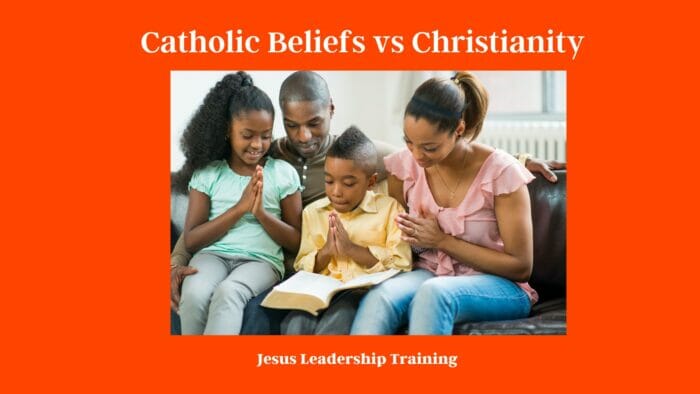Delving into the profound similarities and differences between Catholic beliefs and Christianity. A deep dive into their origins, practices, and teachings, revealing insights to clarify misconceptions.
Table of Contents
Catholic Beliefs vs Christianity
Below is a table detailing the similarities and differences between Catholicism and Christianity. Note that when we discuss “Christianity” here, we’re typically referring to Protestantism since Catholicism is itself a branch of Christianity.
| Aspect | Catholicism | Christianity (Protestantism) |
|---|---|---|
| Belief in Jesus | Believes in Jesus as the Savior and Son of God. | Believes in Jesus as the Savior and Son of God. |
| Bible | Uses the Catholic Bible, which includes the Apocrypha. | Typically uses a Bible without the Apocrypha. |
| Salvation | Achieved through faith, good works, and the sacraments. | Typically emphasized as by faith alone. |
| Sacraments | Seven sacraments recognized. | Number and type vary, but often fewer than Catholics. |
| Tradition | Holds to both Sacred Tradition and the Bible. | Typically upholds the Bible as the sole authority. |
| Papal Authority | Recognizes the Pope as the highest earthly authority. | Does not recognize papal authority. |
| Original Sin | Believes in original sin and necessitates baptism for removal. | Similar belief but may vary on baptism’s role. |
| Eucharist | Believes in transubstantiation (bread & wine become Christ’s body & blood). | Symbolic remembrance, no actual change in elements. |
| Virgin Mary | Venerated; beliefs in Immaculate Conception and Assumption. | Respected but not venerated; other beliefs not held. |
| Prayer Intercessors | Pray to saints and Mary as intercessors. | Direct prayer to God, without human intercessors. |
| Church Governance | Hierarchical with Pope at the top. | Varies widely; many are congregational in governance. |
| Afterlife & Purgatory | Believes in heaven, hell, and purgatory. | Believes in heaven and hell; majority reject purgatory. |
Similarities:
- Both believe in the Trinity: Father, Son, and Holy Spirit.
- Both accept the authority of the Bible.
- Both emphasize the death and resurrection of Jesus Christ.
- Both partake in the practice of baptism and communion, though understandings might differ.
- Both await the Second Coming of Christ.
Differences:
- Different perspectives on sources of authority: Catholics give weight to Sacred Tradition, while many Protestant denominations prioritize sola scriptura or the Bible alone.
- Varied beliefs about the role of the Virgin Mary and the saints.
- Differences in church governance and structure.
- Varied beliefs about sacraments and their significance.
- Different understandings of concepts like purgatory and the nature of the Eucharist.
It’s essential to recognize that the broad term “Christianity (Protestantism)” encompasses a vast array of denominations, each with its nuances in belief and practice. This table provides a generalized overview.
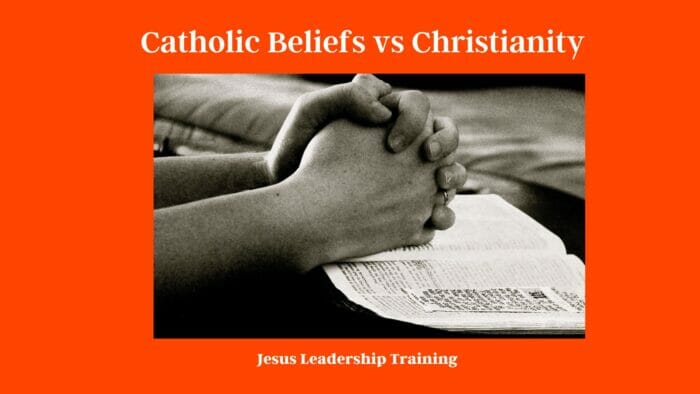
Origins of Catholicism
In the annals of religious history, the origin of Catholicism is intertwined with the origin of Christianity. After all, Catholicism is, in essence, a branch of Christianity.
It’s important to clarify from the outset that Catholicism is a branch of Christianity. Christianity began with the teachings of Jesus Christ in the 1st century A.D. The term “Christianity” encompasses all the religious traditions that trace their origins to Jesus Christ. Catholicism, specifically, refers to the tradition associated with the Bishop of Rome (the Pope) and the Roman Catholic Church.
However, the differentiation between Catholicism and other branches of Christianity primarily came to light during events like the Great Schism and the Protestant Reformation. Let’s break this down in a table format:
| Aspect | Catholicism | Other Early Christian Traditions |
|---|---|---|
| Origins | Developed in the early Christian communities of the Roman Empire. | Originated in various regions of the Roman Empire and beyond. |
| Leadership | Developed the Papacy, recognizing the Bishop of Rome as the supreme leader by the end of the first millennium. | Various leaders like patriarchs, bishops, or elders depending on the tradition. |
| The Great Schism (1054 A.D.) | Alignment with the Roman (Western) Church. This schism separated them from the Eastern Orthodox Church. | The Eastern Orthodox Church split from the Roman Church during this schism. |
| Theological Emphasis | Over time, emphasized doctrines like Papal infallibility, transubstantiation, and the immaculate conception. | While theological beliefs varied, the Eastern Orthodox Church, for instance, rejected certain Roman Catholic doctrines. |
| Liturgical Language | Latin became the principal language of the liturgy in the West. | Languages like Greek, Coptic, and Syriac were prominent in other Christian traditions. |
| Crusades | The Roman Church initiated the Crusades primarily to reclaim the Holy Land. | Eastern Christians often found themselves caught between Crusaders and Muslims. |
| Protestant Reformation (16th century) | Rejected the teachings of Protestant Reformers, leading to the Counter-Reformation to address internal issues and reaffirm Catholic doctrine. | Protestantism emerged as a reaction against certain Catholic practices and doctrines. |
Clarification:
- Both Catholicism and other early Christian traditions share the foundational tenets of Christianity and recognize the authority of the Bible and the core creeds of the early church (e.g., Nicene Creed).
- While this table emphasizes distinctions between Catholicism and other early Christian traditions, it’s important to note the myriad commonalities they share.
The differentiation of Catholicism from other Christian traditions is a result of both theological developments and historical events. Over time, these distinctions became more pronounced, leading to the rich tapestry of Christian denominations we observe today.
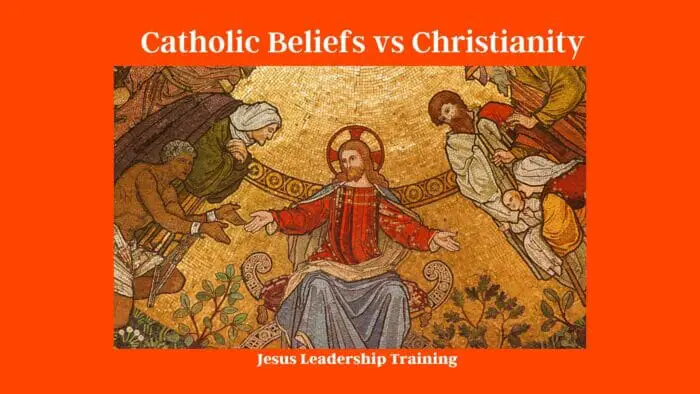
Origins of Christianity
Christianity began around the 1st century AD, rooted in the teachings of Jesus Christ. It rapidly spread across the Roman Empire and transformed into various denominations over time, one of them being Catholicism.
The origins of Christianity are deeply rooted in historical, theological, and cultural developments of the 1st century A.D. Here’s a comprehensive table outlining the beginnings and pivotal moments of early Christianity:
| Aspect | Description |
|---|---|
| Foundation | Based on the teachings, life, death, and resurrection of Jesus Christ in the 1st century A.D. in Judea. |
| Key Texts | The New Testament, including the Gospels (accounts of Jesus’ life), letters (epistles), and the Book of Revelation. |
| Early Leaders | Jesus Christ is the central figure. Early apostles like Peter, Paul, James, and John played significant roles in spreading and shaping Christian teachings. |
| First Followers | Initially consisted of Jewish followers who recognized Jesus as the Messiah. They were known as Jewish-Christians or Judeo-Christians. |
| The Jerusalem Council (circa 50 A.D.) | Early leaders met to discuss the inclusion of Gentiles (non-Jews) in the Christian movement without undergoing Jewish customs like circumcision. This was a pivotal moment that broadened Christianity’s appeal beyond Jewish communities. |
| Spread | Early missionaries, notably Paul, journeyed across the Roman Empire, establishing Christian communities in cities like Antioch, Ephesus, Corinth, and Rome. |
| Persecutions | Early Christians faced intermittent persecutions from Roman authorities and Jewish leadership. They were often marginalized for their refusal to participate in pagan ceremonies and for their exclusive devotion to Christ. |
| Edict of Milan (313 A.D.) | Emperor Constantine legalized Christianity, ending major persecutions. This decree paved the way for Christianity to become a dominant religion in the Roman Empire. |
| First Council of Nicaea (325 A.D.) | The first ecumenical council convened to address theological disputes, most notably the nature of Christ’s divinity. The Nicene Creed, a statement of Christian faith, was formulated here. |
| Establishment as State Religion (380 A.D.) | Emperor Theodosius declared Christianity the state religion of the Roman Empire, further cementing its central place in the western world. |
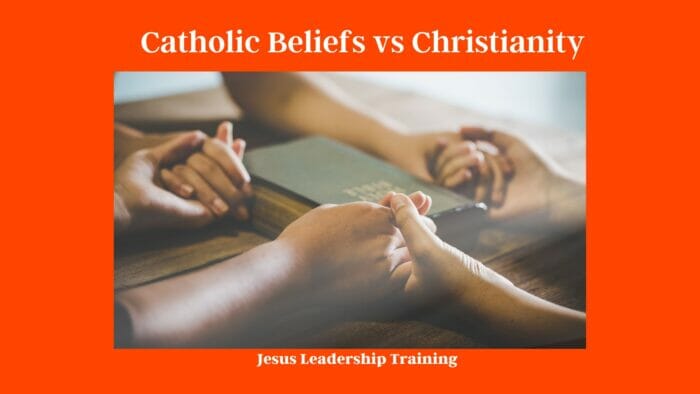
Clarification:
7 Major Differences between Catholicism and other Christian denominations
At a glance, the differences between Catholicism and other Christian denominations can seem subtle, but delve a little deeper, and the distinctions are quite pronounced. From the significance of the Pope to certain sacraments like Confirmation, the Catholic Church has its unique traditions.
Let’s clarify one fundamental point before moving forward: Catholicism is a subset of Christianity. Therefore, when we speak of differences between Catholicism and “Christianity,” we’re essentially comparing Catholicism to other Christian denominations. Here’s an authoritative presentation of seven key differences:
- Authority of the Pope:
- Catholicism: Recognizes the Pope as the supreme spiritual leader and the Bishop of Rome. He holds the keys of authority passed down from Saint Peter, whom Catholics believe was appointed by Christ as the first head of His church.
- Other Christian Denominations: Most do not recognize the Pope’s authority. Leadership structures vary across denominations, with some governed by councils, others by individual pastors or elders, and so forth.
- Sacraments and Practices:
- Catholicism: Emphasizes seven sacraments: Baptism, Confirmation, Eucharist, Penance (Reconciliation or Confession), Anointing of the Sick, Holy Orders, and Matrimony.
- Other Christian Denominations: The number and nature of sacraments or ordinances can vary. Most Protestant denominations, for instance, recognize only two: Baptism and the Lord’s Supper (or Communion).
- Veneration of Saints:
- Catholicism: Practices the veneration of saints, especially the Virgin Mary. Catholics believe saints can intercede on behalf of individuals, so they often pray through saints.
- Other Christian Denominations: Generally do not venerate saints to the extent Catholics do. While many recognize the historical and spiritual significance of saints, they don’t typically pray through them.
- Source of Theological Authority:
- Catholicism: Relies on both the Bible and Sacred Tradition as equally authoritative sources of faith and practice. The Magisterium, or teaching authority of the Church, provides interpretation.
- Other Christian Denominations: Especially among Protestant groups, the Bible alone (“sola scriptura”) is emphasized as the primary or sole source of theological authority.
- Views on Salvation:
- Catholicism: Emphasizes a combination of faith and works in the salvation process. Sacraments, especially the Eucharist, play a pivotal role in one’s sanctification.
- Other Christian Denominations: Many Protestant denominations stress salvation by faith alone (“sola fide”) in Jesus Christ.
- Eucharistic Beliefs:
- Catholicism: Believes in transubstantiation, the doctrine that during the Mass, the bread and wine become the actual body and blood of Christ.
- Other Christian Denominations: Views vary, but many believe in a symbolic interpretation of the Eucharist, where the bread and wine represent Christ’s body and blood but don’t transform into them.
- Church Tradition and Liturgy:
- Catholicism: Has a rich liturgical tradition with set prayers, rituals, and church seasons. The Mass is central to worship.
- Other Christian Denominations: Worship styles and liturgies can vary widely, ranging from highly structured to more spontaneous and informal.
In conclusion, while all Christian denominations share a foundational belief in Jesus Christ as Savior, the practices, traditions, and interpretations of doctrine can differ significantly. Catholicism, with its deep historical roots and global reach, remains distinct in various aspects of belief and practice from other Christian traditions.
7 Major Similarities between Catholicism and other Christian denominations
At their core, both Catholicism and other Christian denominations believe in the Holy Trinity, the Bible, and the life and teachings of Jesus Christ. Sacraments like baptism are universally acknowledged and celebrated.
- Foundation in Jesus Christ:
- Catholicism and Other Christian Denominations: Both affirm the belief in Jesus Christ as the Son of God, the Savior of humanity. His teachings, crucifixion, resurrection, and promise of eternal life are central to all Christian faith traditions.
- The Holy Bible:
- Catholicism and Other Christian Denominations: Both recognize the Holy Bible as a sacred and authoritative text, encompassing the Old and New Testaments. While there may be variations in some books (especially in the Old Testament between Catholic and Protestant Bibles), the core teachings and narratives are consistent.
- Trinitarian Doctrine:
- Catholicism and Other Christian Denominations: Both adhere to the doctrine of the Holy Trinity, recognizing God as one entity in three persons: Father, Son, and Holy Spirit.
- Importance of Faith:
- Catholicism and Other Christian Denominations: All emphasize the significance of faith in God and in Jesus Christ as central to salvation and a personal relationship with the Divine.
- Baptism:
- Catholicism and Other Christian Denominations: Consider baptism a sacrament or ordinance, and it is seen as an essential rite of initiation into the Christian faith. While the methods and theology behind baptism can vary (e.g., infant vs. believer’s baptism, immersion vs. sprinkling), its foundational importance is universally recognized.
- The Second Coming:
- Catholicism and Other Christian Denominations: Both hold the belief that Jesus Christ will return to Earth again in what’s referred to as the Second Coming. This event is anticipated as a culmination of God’s divine plan.
- Moral and Ethical Teachings:
- Catholicism and Other Christian Denominations: Both draw from the teachings of Jesus, especially the Sermon on the Mount, to guide moral and ethical behavior. The Ten Commandments, Beatitudes, and other Biblical directives serve as foundational guides for living a righteous life.
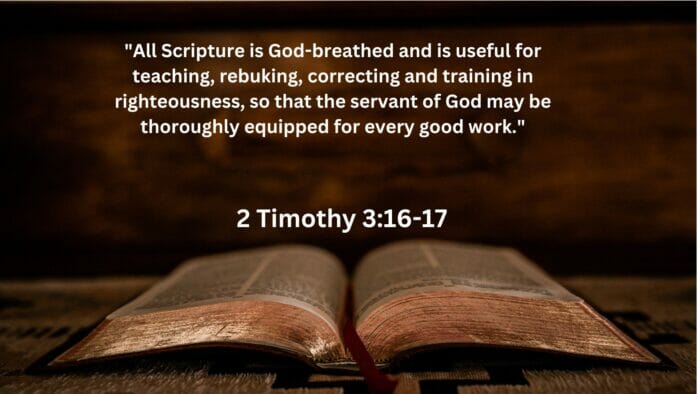
Why Some Argue Catholicism is not Christian
It’s essential to note that this section is based on viewpoints and not an assertion of fact. Many Catholics identify as Christian, but the distinctions are worth exploring.
Biggest Differences
From transubstantiation in the Eucharist to the veneration of Saints, Catholic practices sometimes diverge sharply from other Christian denominations.
Marriage
While most Christian denominations permit their clergy to marry, Catholic priests take a vow of celibacy. Additionally, the Catholic Church has specific stances on annulment and divorce.
Comparison of Catholic Marriage to General Christian Marriage
| Aspect | Catholic Marriage | General Christian Marriage |
|---|---|---|
| Foundational Belief | Marriage is a sacrament, a visible sign of God’s grace. | Marriage is a sacred union, often seen as a covenant between the couple and God, but not always viewed as a sacrament in all denominations. |
| Ceremonial Tradition | Typically held within a Catholic church. Mass is often celebrated as part of the wedding ceremony. | Varies by denomination. Can be held in a church, chapel, or any other venue. Rituals and customs may differ. |
| Officiant | Must be officiated by a Catholic priest or deacon. | Can be officiated by pastors, ministers, elders, or other church leaders, depending on the denomination. |
| Pre-Marital Requirements | Often requires pre-marital counseling known as “Pre-Cana”. Couples might also need to prove their faithfulness to the Church’s teachings. | Varies by denomination. Some might require counseling, while others might have more flexible requirements. |
| Divorce | The Catholic Church does not recognize divorce. Annulment is an option but under specific circumstances. | Views on divorce vary. Some denominations accept it, while others discourage it or have restrictions similar to Catholicism. |
| Remarriage | Remarriage in the Church is not permitted after a divorce unless the previous marriage has been annulled. | Varies by denomination. Some permit remarriage, while others have restrictions or conditions. |
| Role of Mary and Saints | Mary and saints may be invoked in the nuptial blessings and prayers. | Typically, there’s no invocation of Mary or saints in non-Catholic Christian ceremonies. |
| Biblical Foundation | Based on various biblical passages, especially Ephesians 5, and the teachings of Jesus in the Gospels. | While also rooted in biblical teachings, the emphasis and interpretations might differ based on denominational theology. |
| Openness to Interfaith Marriages | While possible, they come with several conditions. The Catholic party must vow to raise the children in the Catholic faith. | Depending on the denomination, there might be more flexibility with interfaith marriages, but some may have their own conditions. |
It’s important to note that “Christian Marriage” encompasses a vast array of traditions and
Baptism
Infant baptism is prevalent in Catholicism, while some other Christian denominations opt for believer’s baptism or baptism upon confession of faith.
Comparison of Catholic Baptism to General Christian Baptism
| Aspect | Catholic Baptism | General Christian Baptism |
|---|---|---|
| Foundational Belief | Baptism is a sacrament, an outward sign instituted by Christ to convey inward grace. It removes original sin. | Baptism symbolizes the believer’s faith in Christ and represents purification. The theological understanding can vary across denominations. |
| Age of Baptism | Infants are baptized. Adult converts are also baptized if they haven’t been before. | Practices vary. Some denominations, like Baptists, practice “believer’s baptism” (only upon confession of faith). Others, like Methodists, baptize infants. |
| Mode of Baptism | Typically, the method is affusion (pouring water) or aspersion (sprinkling water). Full immersion is less common. | Varies by denomination. Many use immersion, but pouring or sprinkling is also practiced in certain denominations. |
| Formulation | “I baptize you in the name of the Father, and of the Son, and of the Holy Spirit.” | Most use the Trinitarian formula, but the exact wording and emphasis can differ. Some might simply use “In the name of Jesus.” |
| Requirements for Baptism | Requires a profession of faith (by parents/sponsors for infants). A period of catechesis (teaching) might precede adult baptism. | Typically requires a profession of faith. The extent of pre-baptismal instruction or catechesis varies by denomination. |
| Officiant | Must be performed by a deacon, priest, or bishop. In emergencies, any layperson can baptize. | Depending on the denomination, baptisms can be performed by ministers, pastors, elders, or other church officials. |
| Sponsors/Godparents | Godparents are chosen for infants, and they make promises on the child’s behalf. They’re expected to guide the child’s spiritual growth. | Some denominations have sponsors or godparents, while others do not. The role and requirements can vary. |
| Post-Baptismal Rites | Often includes rites like the anointing with chrism, wearing of a white garment, and receiving a lit candle. | These additional rites are less common in many non-Catholic denominations, but practices can vary widely. |
| Recognizing Baptisms from Other Denominations | The Catholic Church recognizes baptisms from other Christian denominations as long as they were done with the proper form and intention. | Varies by denomination. Some recognize baptisms from other Christian groups, while others might require rebaptism upon joining. |
Heaven
Purgatory, a concept where souls are purified before entering heaven, is uniquely Catholic and isn’t universally accepted in Christianity.
Comparison of Views on Catholic Heaven to General Christian Heaven
| Aspect | Catholic Heaven | General Christian Heaven |
|---|---|---|
| Basic Understanding | Heaven is the eternal dwelling place of those who have achieved perfect union with God. | Heaven is commonly seen as the eternal paradise where believers dwell with God. Views may vary by denomination. |
| Entrance Criteria | Received the sacraments, died in a state of grace, and have undergone purification in purgatory if needed. | Belief in Jesus Christ as the Savior is the primary criterion. Specifics might vary by denomination. |
| Nature of Existence | A state of perfect happiness and communion with God, the saints, and the angels. Beatific vision (seeing God face-to-face) is emphasized. | Typically viewed as a paradise where there is no suffering and believers are in communion with God. |
| Intercession of Saints | Those in heaven, particularly the saints, can intercede for those on Earth. | This belief is not commonly held in all Christian denominations. Some might only emphasize direct communion with God. |
| Role of Mary | Mary holds a special place in heaven as the Queen of Heaven. | Many non-Catholic denominations do not assign a specific role or title to Mary in heaven. |
| Purgatory’s Role | Purgatory is seen as a temporary state for souls to be purified before entering heaven. | Most non-Catholic denominations do not believe in purgatory, seeing salvation as a direct result of faith in Christ. |
| Levels or Hierarchies | While heaven itself is perfect union with God, there are nuances in the rewards based on one’s deeds on Earth. | While some traditions hold views of varying rewards, many emphasize equality in the presence of God. |
| Eternal Aspect | Heaven is eternal and unchanging. | Generally agreed upon across Christian denominations that heaven represents eternal life with God. |
| Biblical Foundations | Grounded in various biblical passages, including Revelation, the Gospels, and Pauline letters. | Based on the Bible, with interpretations varying somewhat by denomination. The book of Revelation is often cited. |
| Resurrection of the Body | The body will be gloriously resurrected and reunited with the soul at the end of times. | Most Christian denominations believe in a bodily resurrection, though specifics about the nature of the resurrected body can vary. |
Is Catholicism a form of Christianity?
The question’s answer, in many ways, lies in the eye of the beholder. But for an informed perspective, let’s analyze both sides of the coin.
14 Reasons Why Catholicism is a form of Christianity
Historically, theologically, and fundamentally, Catholicism emerges from the Christian faith. It honors the Bible, Jesus Christ, and follows Christian teachings.
- Historical Origins: Catholicism traces its roots directly back to the apostolic community founded by Jesus Christ. Historically, the Catholic Church considers itself the original Christian Church.
- Core Beliefs: Like all Christian denominations, Catholics believe in the Holy Trinity: the Father, the Son (Jesus Christ), and the Holy Spirit. The divinity of Jesus and His role as the Savior is central to Catholic doctrine.
- The Bible: The Catholic Church uses the Bible as a foundational text, containing both the Old and New Testaments. While there are additional books in the Catholic Old Testament (known as the Deuterocanonical books), the essence and message of the Bible are consistently Christian.
- Sacraments: Catholics, like many other Christian denominations, have sacraments that mark significant events in believers’ spiritual lives. These include Baptism, the Eucharist (Communion), and others.
- Apostolic Succession: The Catholic Church believes in apostolic succession, the idea that the Pope and bishops trace their spiritual lineage back to the apostles, particularly Peter, whom they believe was entrusted by Christ with the leadership of His Church.
- Creeds: Catholics recite the Nicene Creed and the Apostles’ Creed, both of which are foundational Christian statements of faith.
- Early Church Councils: The Catholic Church participated in and often convened the early ecumenical councils, such as the Council of Nicaea and the Council of Chalcedon, which shaped core Christian doctrines.
- Missionary Efforts: Since its inception, the Catholic Church has been instrumental in spreading Christianity worldwide.
- Martyrdom and Saints: Many early Christian martyrs, who died for their belief in Christ, are venerated as saints in the Catholic Church.
- Traditions of Worship: Catholic liturgy, particularly the Mass, centers on the life, death, and resurrection of Jesus Christ, reflecting the core narrative of Christianity.
- Symbols: Symbols like the cross, the fish (Ichthys), and the chi-rho (an ancient Christian symbol) are used both in Catholicism and wider Christianity.
- Theological Foundations: Key Christian theologians, like St. Augustine and St. Thomas Aquinas, who influenced Christian thought as a whole, were Catholic.
- Unity with Other Christians: The Catholic Church recognizes other Christian denominations as part of the broader Christian community, even if there are significant theological differences.
- Eschatological Beliefs: Catholic teachings on the afterlife, including beliefs about Heaven, Hell, and the resurrection of the body, align with broader Christian beliefs.
In essence, while there are distinctive beliefs and practices within Catholicism, its core tenets, history, and traditions firmly place it within the broader umbrella of Christianity.
13 Reasons Why Catholicism is Not a form of Christianity
Certain specific beliefs and practices, from papal infallibility to the role of Mary, make Catholicism distinct from other Christian denominations.
It’s important to note that the overwhelming consensus among scholars and theologians is that Catholicism is a form of Christianity. However, there are some groups or individuals that claim Catholicism is not “true” Christianity based on certain arguments. Here’s a summary of those arguments:
Reasons Claimed by Some as to Why Catholicism is Not a Form of Christianity:
- Extra-Biblical Traditions: Critics argue that Catholicism has incorporated traditions and practices that are not found in the Bible, such as praying to saints, veneration of Mary, and the authority of the Pope.
- Papal Authority: Some Christians believe that the Pope’s claim to spiritual authority is unbiblical. They argue that Jesus Christ alone is the head of the Church, not any human leader.
- Salvation through Works: Some claim that the Catholic Church teaches salvation through works, not just through faith in Jesus Christ. This claim, however, is a misunderstanding, as Catholic doctrine teaches salvation by God’s grace, which manifests in faith and works.
- The Sacrament of the Eucharist: The Catholic belief in transubstantiation, where the bread and wine become the actual body and blood of Christ during the Eucharist, is seen by some as unbiblical and even idolatrous.
- Veneration of Mary and Saints: Some believe that the special emphasis the Catholic Church places on Mary and the saints borders on idolatry, diverting focus from Christ.
- The Apocrypha: Catholics include several books in their Old Testament (the Deuterocanonical books) that are not found in many Protestant Bibles. Critics argue that these books shouldn’t be considered canonical Scripture.
- Confession to Priests: The practice of confessing sins to a priest for absolution is seen by some as an unbiblical tradition.
- Purgatory: The concept of purgatory, an intermediate state where souls undergo purification before entering heaven, is not explicitly mentioned in the Bible and is therefore rejected by some Christian denominations.
- Reliance on Church Tradition: Some argue that the Catholic Church gives equal or even greater weight to church traditions than to Scripture.
- Clerical Celibacy: The Catholic Church’s practice of requiring celibacy for its priests is seen by some as contrary to biblical teachings where clergy had families.
- Critiques of Church History: Some point to historical events, like the Crusades or the Inquisition, as evidence that the Catholic Church has deviated from true Christian teachings.
- Disagreement on Core Doctrines: Some Protestant denominations believe that certain Catholic doctrines, like the Immaculate Conception of Mary or the Assumption, are not grounded in the Bible.
- Church Wealth and Opulence: Some criticize the wealth and opulence of the Vatican and certain cathedrals, believing it contrasts with the humility and simplicity taught by Jesus.
Hierarchy
While there are leaders and clergy, there’s no centralized figure akin to the Pope in many Christian denominations.
| Aspect | Roman Catholic Church | General Christianity (Mainstream Protestantism) |
|---|---|---|
| Highest Authority | Pope (Bishop of Rome) | Jesus Christ (interpreted through Scripture) |
| Regional Leaders | Cardinals, Archbishops | Regional or national church leaders (e.g., Moderators, Bishops) |
| Local Leaders | Bishops | Pastors, Ministers |
| Priesthood | Ordained priests and deacons | Lay ministers, Elders |
| Doctrine Determination | Magisterium (Pope and Bishops in union with him) | Church councils, synods, or congregational votes |
| Lay Participation in Governance | Limited; consultative roles in synods | Often have significant roles, including voting on key issues |
| Approach to Tradition | Sacred Tradition and Sacred Scripture | Sola Scriptura (Scripture alone) |
| Liturgical Roles | Ordained ministers (priests, deacons) officiate sacraments | Depending on denomination, both clergy and laity can officiate |
| Evangelization | Done by missionaries, priests, religious orders, and laity | Done by missionaries, ministers, and laity |
| Means of Grace/Sacraments | Seven sacraments administered by ordained priests | Typically two (Baptism & Lord’s Supper), administered by ministers |
| View on Apostolic Succession | Direct line of succession from Peter | Varied; some maintain a form of it, others do not |
Final Thoughts
The discourse on Title – Catholic beliefs vs Christianity will continue, with perspectives evolving over time. At its heart, it’s a dialogue about shared faith, diverse interpretations, and mutual respect.
FAQs
What’s the primary difference between Catholicism and Christianity?
While Catholicism is a branch of Christianity, it’s distinguished by its traditions, sacraments, and the role of the Pope.
Do Catholics read the Bible?
Yes, the Bible is fundamental to Catholic faith and teachings.
Why do some Christians not consider Catholics as fellow Christians?
It stems from theological differences, with some believing that certain Catholic practices deviate from Biblical teachings.
Is the Pope unique to Catholicism?
Yes, the Pope, as the Bishop of Rome, is a distinct figure in Catholicism.
What’s the Catholic stance on Purgatory?
Catholics believe in Purgatory as a place where souls are purified before entering Heaven.
Do all Christian denominations believe in the Holy Trinity?
Most do, but interpretations might vary.
The discussion on Catholic beliefs vs Christianity is not about division but understanding. It’s a testament to Christianity’s rich tapestry and the myriad ways faith manifests. By understanding these distinctions, we can foster a more inclusive and harmonious religious landscape.



